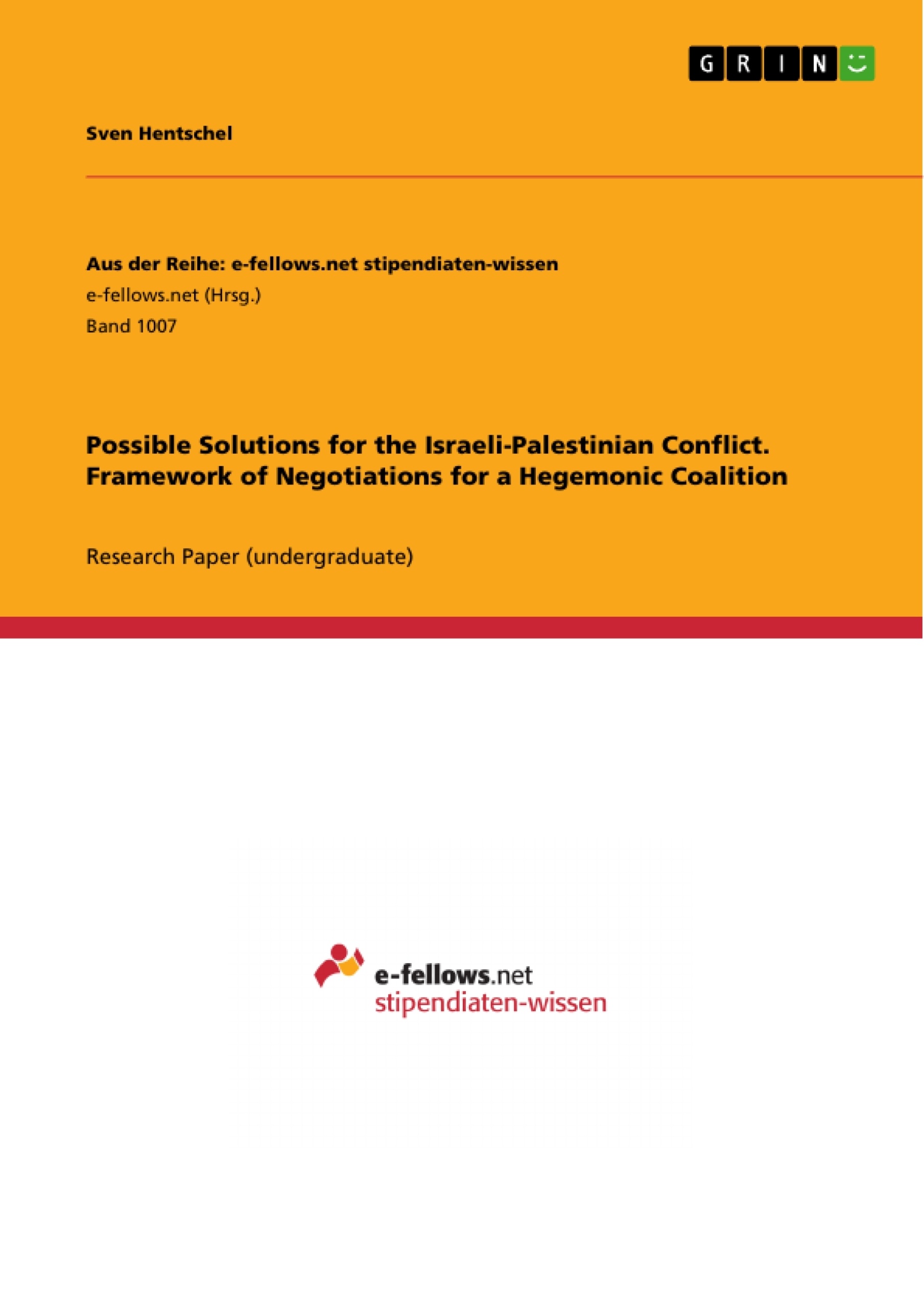Throughout history there have been many attempts to establish peace between Israel and Palestine but all of these attempts were to no avail. This term paper will examine the underlying problem why all these attempts could not lead to a mutually satisfactory solution and will then describe what needs to be done in order to establish a new and sustainable peace agreement between Israel and Palestine.
To do so this paper firstly illustrates the historical background of previous peace negotiations before describing the complex relationship of Israel and Palestine on an internal, regional and external level. It will then look at the opposed positions of both parties and illustrates to what extent the model of the Prisoner’s Dilemma can explain the situation that both sides are facing. Based on these findings ways how to potentially resolve this dilemma will be presented. The most promising solution of a Hegemonic Coalition that can put pressure on both parties to negotiate with each other over interests rather than positions will be explained in detail. Especially the framework under what conditions the negotiations should take place to avoid mistakes made by the Oslo peace negotiations will be addressed. Under consideration of that framework this paper develops a potential solution how the agreement between Israel and Palestine could look like to achieve peace between both parties.
The Israel-Palestine peace process can be seen as a series of attempts to establish a lasting end to the Israeli-Palestinian conflict. Some of these attempts were more promising than others but until now none of them could establish peace between both parties.6 The decision tree in the appendix (Figure 1) helps to give a short overview of the main stages taken towards peace in the region. Throughout that paper some of these stages will need to be examined in further detail but for now this overview is sufficient to see that negotiations between both parties continuously failed mainly due to the unstable political environment within Israel and Palestine.
Inhaltsverzeichnis (Table of Contents)
- Introduction
- Peace Process
- Relationship of Israel and Palestine - Internal and External.
- Positions........
- Prisoner's Dilemma
- Resolving the Prisoner's Dilemma.
- Tit-for tat.
- Hegemonic Coalition.
- The two-level game.
- Framework for a new peace negotiation .......
- Conclusion.
Zielsetzung und Themenschwerpunkte (Objectives and Key Themes)
This paper aims to analyze the complex relationship between Israel and Palestine, examining the historical context, internal and external factors influencing the conflict, and the challenges hindering peace negotiations. It explores potential solutions, focusing on the concept of the Prisoner's Dilemma and the possibility of a Hegemonic Coalition to resolve the ongoing conflict.
- Historical Context of the Israel-Palestine Conflict
- Internal and External Dynamics Influencing the Conflict
- The Prisoner's Dilemma as a Framework for Understanding the Conflict
- Potential Solutions and Strategies for Peace Negotiations
- The Importance of a Hegemonic Coalition in Facilitating Dialogue and Compromise
Zusammenfassung der Kapitel (Chapter Summaries)
The first chapter introduces the ongoing conflict between Israel and Palestine, highlighting its historical roots and its significance as one of the world's longest-standing conflicts. It outlines the paper's objective to explore the underlying challenges preventing a lasting peace agreement and to propose potential solutions.
Chapter two provides an overview of the Israel-Palestine peace process, highlighting the numerous attempts at reconciliation and their ultimate failure. The chapter suggests that the unstable political environment within both countries has been a major factor contributing to the impasse.
Chapter three delves into the complex internal and external dynamics of the Israel-Palestine relationship. It analyzes the diverse political landscape within both countries, highlighting key players and their respective stances on the conflict. Additionally, it explores the impact of regional and international actors on the conflict, emphasizing the role of key players such as the Arab League, the United States, and the European Union.
Chapter four examines the opposing positions of Israel and Palestine, illustrating how the model of the Prisoner's Dilemma can be applied to understand the conflict. It highlights the strategic advantages of maintaining a firm stance despite the potential for mutual benefits through cooperation.
Chapter five presents potential strategies for resolving the Prisoner's Dilemma and creating a path towards sustainable peace. It explores the concept of a Hegemonic Coalition, arguing that external pressure on both parties could encourage them to prioritize negotiation and compromise over rigid positions.
Schlüsselwörter (Keywords)
The keywords in this text include: Israel-Palestine conflict, peace process, Prisoner's Dilemma, Hegemonic Coalition, two-level game, negotiations, political environment, international actors, regional dynamics, historical context, solutions, strategies, sustainable peace.
- Quote paper
- B.Sc. Sven Hentschel (Author), 2012, Possible Solutions for the Israeli-Palestinian Conflict. Framework of Negotiations for a Hegemonic Coalition, Munich, GRIN Verlag, https://www.grin.com/document/281184




